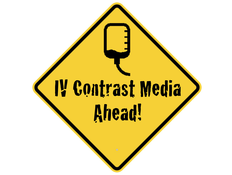 What's the Problem? Most radiologic exams, especially computed tomography (CT) scans, use iodinated contrast media in order to improve image quality and therefore diagnostic accuracy. The decision on whether to use IV contrast media is also made on the background of pre-existing renal function as the use of these agents has been linked to increased risk of adverse events like: acute kidney injury, initiation of dialysis, renal failure, stroke, myocardial infarction, and death. -> So called 'contrast-induced nephropathy' or short CIN! The REAL PROBLEM is that randomising patients to receive or not receive a contrast-enhanced imaging study when indicated is simply not feasible. - It has been presumed that these agents are a direct cause of acute kidney injury - and therefore dangerous ☠ But, Hold On: Is There Really a Problem? The causal relationship between the application of IV contrast media and the development of acute kidney injury has recently been questioned - Seriously questioned! - It is interesting to notice that most of our current understanding of contrast-induced nephropathy derives from arterial angiography studies. - Also, many studies looking into this problem were performed without any control populations. These investigators obviously assumed that CIN undoubtably exists but did not compare their cohort to patients not receiving contrast media! Mitchell AM et al. nn Emerg Med. 2015 Sep;66(3):267-274 or Mitchell AM et al. lin J Am Soc Nephrol. 2010 Jan;5(1):4-9. doi: 10 and more! 🤔 - As a matter of fact, serum creatinine level fluctuations (meeting the criteria for contrast induced nephropathy) occur in patients in patients undergoing unenhanced CT at similar rates to those published after contrast-enhanced CT. Newhouse JH et al. (see reference below) for instance looked at a total of over 32'000 patients and noticed that creatinine level increases in patients who are not receiving contrast material as often as it does in published series of patients who are receiving contrast material. AJR Am J Roentgenol. 2008 Aug;191(2):376-82 Newhouse already suspected that CIN may have been overestimated so far! Also other studies found no increased of acute kidney injury after after contrast media administration in any patient group, regardless of baseline renal function. Crit Cloud review from March 2014 Crit Cloud review from January 2015 Maybe There is No Major Problem Two recently published paper further challenge the paradigm of contrast-induced nephropathy. Hinson J et al. published a single-center retrospective cohort study in 2016 in which a total of 17'934 patient visits to their emergency department over a period of 5 years were included. They analysed three patient groups that where demographically similar: contrast-enhanced CT, unenhanced CT and no CT scan performed. In this largest controlled study of it's kind no difference was found in the incidence of acute kidney injury. Hinson J et al. Annals of Emergency Medicine, 2017; DOI: 10.1016/j.annemergmed.2016.11.021 And just now Wilhelm-Leen et al. have published their analysis of almost 6'000'000 hospitalised patients in the united states and their risk of radio-contrast associated nephropathy. Their results strongly suggest, that the incremental risk of AKI that can be attributed to contrast-media is modest at worst, and almost certainly overestimated! Wilhelm-Leen Emilee, J Am Soc Nephrol 28: 653-659,2017 A most recent editorial by Lopez-Ruiz at al. puts this new knowledge into a new perspective. J Am Soc Nephrol. 2017 Feb;28(2):397-399 - If contrast induced nephropathy does exist, it's relevance in clinical practice seems to have been overestimated so far! Is There a Way to Prevents Contrast-Induced Nephropathy? The application of sodium bicarbonate, N-acetylcysteine, statins, ascorbic acid and pre-hydration with IV fluids have been recommended for the prevention of CIN in patients with compromised renal function. Among all of these measures hydration with intravenous saline is considered the cornerstone in the prevention of CIN. And luckily enough just now The Lancet provides us with a first answer to this specific question. The AMAZING trial published in February 2017 provides fairly good evidence that prophylactic hydration with normal saline does not lower the incidence of CIN. EC Nijssen et al. The Lancet, Feb. 2017 The Bottom Line: - Until proven otherwise IV contrast media should be considered potentially nephrotoxic. This is supported by preclinical and cardiac studies. If this is relevant in clinical practice (escpecially for CT scans) is not proven so far... but also difficult to disapprove! - The risk of contrast-induced nephropathy certainly has been oversetimated so far! - While prophylactic hydration of the patient has no benefit in regards of CIN, keeping patients well hydrated in general is certainly strongly recommended. - Quick and proper treatment of the patients underlying condition is most probably more important than worrying about CIN and therefore withholding an indicated enhanced CT-scan! Comments are closed.
|
Search
|


 RSS Feed
RSS Feed


